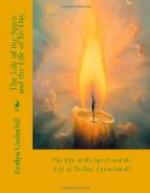This conception of the multiplicity in unity of the psyche, conscious and unconscious, is probably one of the most important results of recent psychological advance. It means that we cannot any longer in the good old way rule off bits or aspects of it, and call them intellect, soul, spirit, conscience and so forth; or, on the other hand, refer to our “lower” nature as if it were something separate from ourselves. I am spirit when I pray, if I pray rightly. I am my lower nature, when my thoughts and deeds are swayed by my primitive impulses and physical longings, declared or disguised. I am most wholly myself when that impulsive nature and that craving spirit are welded into one, subject to the same emotional stimulus, directed to one goal. When theologians and psychologists, ignoring this unity of the self, set up arbitrary divisions—and both classes are very fond of doing so—they are merely making diagrams for their own convenience. We ourselves shall probably be compelled to do this: and the proceeding is harmless enough, so long as we recollect that these diagrams are at best symbolic pictures of fact. Specially is it necessary to keep our heads, and refuse to be led away by the constant modern talk of the primitive, unconscious, foreconscious instinctive and other minds which are so prominent in modern psychological literature, or by the spatial suggestions of such terms as threshold, complex, channel of discharge: remembering always the central unity and non-material nature of that many-faced psychic life which is described under these various formulae.
If we accept this central unity with all its implications, it follows that we cannot take our superior and conscious faculties, set them apart, and call them “ourselves”; refusing responsibility for the more animal and less fortunate tendencies and instincts which surge up with such distressing ease and frequency from the deeps, by attributing these to nature or heredity. Indeed, more and more does it become plain that the sophisticated surface-mind which alone we usually recognize is the smallest, the least developed, and in some respects still the least important part of the real self: that whole man of impulse, thought and desire, which it is the business of religion to capture and domesticate for God. That whole man is an animal-spirit, a living, growing, plastic unit; moving towards a racial future yet unperceived by us, and carrying with him a racial past which conditions at every moment his choices, impulses and acts. Only the most rigid self-examination will disclose to us the extent in which the jungle and the Stone Age are still active in our games, our politics and our creeds; how many of our motives are still those of primitive man, and how many of our social institutions offer him a discreet opportunity of self-expression.




